About Language Itself
Presently, there are scores of languages being spoken by various people; with hundreds of dialects. A "dialect" occurs when people speaking the same language speak somewhat differently. For example: Jamaicans, Brittians, Americans and Irishmen all speak English. Yet, each group has it's own "dialect".
In the beginning, all humans spoke the same language. Even after the Great Flood, when the sons of Noah settled in the land of Sumer (biblical: Shinar) they still all spoke the same language (ref. Gen. 11:1-2). Then, the Great Confusion occurred. Each household, at that time, was enchanted by the Almighty, to have a particular language. Thus, the diversity of human language was created. And, this diversity was created in order to confuse, confound, divide, and separate the families of the humans.
It is important to understand that nations did not exist until the Great Confusion of the Language. At that time (approx. 4,361 years ago) all the families of the earth were forced to separate; each family having it's own language (ref. Gen. 11:7-9).
The household of Eber (ref. Gen. 11:10-17) was given the language we call "Hebrew". In fact, the word "hebrew" contains the name Eber (i.e. "ebr"). The exact timing of the Great Confusion of the language is based on knowing that Peleg, son of Eber, was born in the same year of the Great Confusion! (ref. Gen. 10:25)
The Timeline shown below shows how the date of the Great Confusion is figured:

The Confusion of Languages occurred approx. 4,361 years ago. This very accurate dating is based on knowing the secular date of the start of Solomon's Temple. From that date (967 b.c.e.), the Holy Scriptures provides enough information to construct a very accurate Timeline.
The condensed Timeline shown below shows how the exact year of the Great Confusion is calculated; based on the birth of Peleg, son of Eber.

About Written Language
The first type of written language, after the Great Confusion, was "picture" writing. The humans used simple pictures to say - in writing - the things they wanted to convey. "Cuneiform" is the term applied to the picture writing of the early Shemites (i.e. Sumerians; Babylonians). "Hieroglyphics" is the term used to describe the picture writing of the early Hamites (i.e. Egyptians; Hittites; Canaanites).
Presently, only people of the Orient still write by using pictures. All others have abandoned their early use of picture writing, for the modern method of "sound writing".
Another word for "sound language" is Phonetic Language. Taken from the Greek word "phone" (Eng. "sound"), the characters of a phonetic language represent "sounds", as opposed to representing "concepts".
Most Israelite scholars credit the patriarch Abraham with the invention of "sound language". Using just twenty-two of the hundreds of Canaanite hieroglyphs, Abraham was able to express words using "sound representations".
The chart below shows how modern phonetic letters were developed from ancient hieroglyphs.
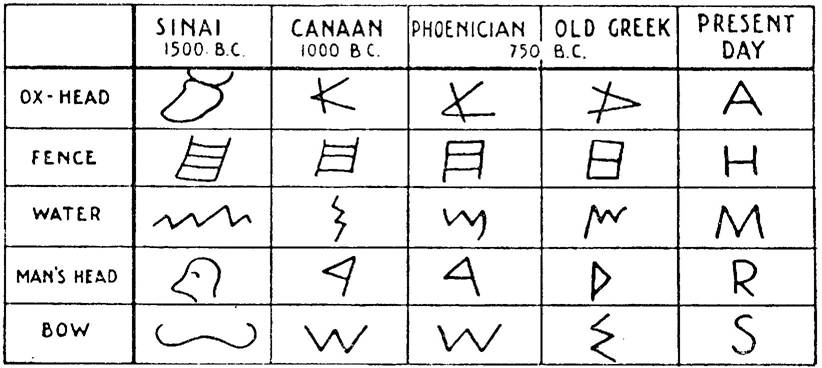
All modern letters are conversions of ancient hieroglyphs. When read as a hieroglyph, the ox-head symbol and the fence symbol would represent the concept of a "corral". But, when read as a phonetic expression, the ox-head symbol is pronounced "ah", and the fence symbol is pronounced "kh". Thus, the word would be "akh" - which means "brother" in Hebrew.
About the Hebrew Language
The word "Hebrew" refers to both a language and a people; as do all words that describe a language. For example: the Chinese speak Chinese; the Russians speak Russian; the Spanish speak Spanish; etc.
The patriarch Abraham was the sixth generation of Eber. He spoke the language of Eber, and was even called "the Hebrew" (ref. Gen. 14:13).
It is believed that Abraham invented "sound language" in order to communicate with the many other nations of people he came in contact with during his migration from Ur, to Egypt. He sojourned with Arameans, Assyrians, Hittites, Canaanites, Philistines, and Egyptians. Using his twenty-two letter "alphabet", he was able to convert any word - from any language - into a "sound representation".
The chart below shows Abraham's original twenty-two letter alphabet...used over 3,ooo years ago.
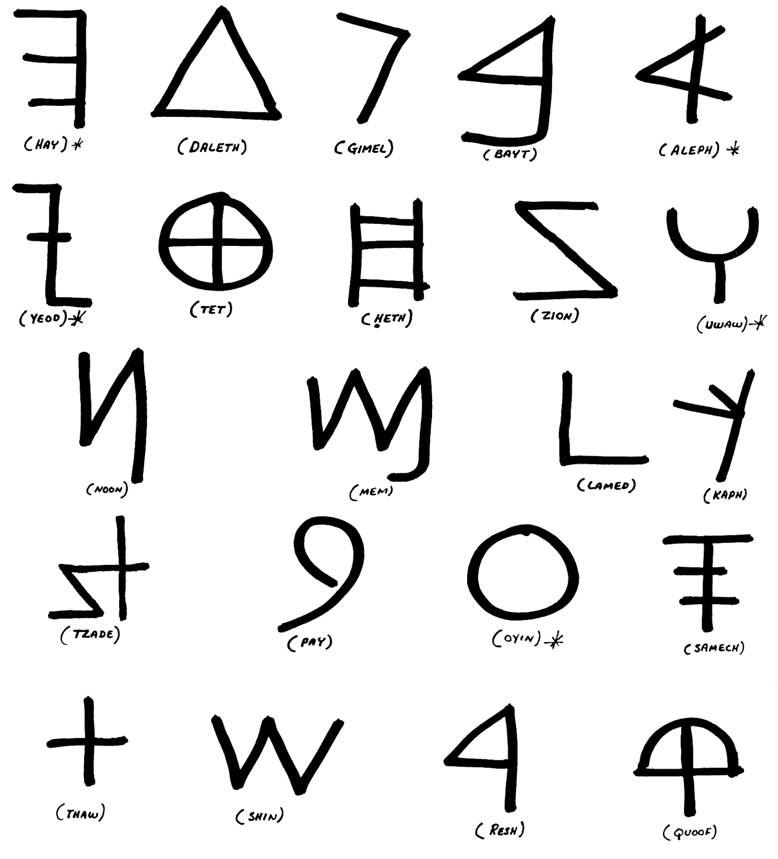
From the times of Abraham, 'till the times of king David, the Hebrews used this Ancient Hebrew Script. The original Torah, and the original books of the Old Testament were written in this same ancient script. Presently, very little physical evidence of this ancient Hebrew script even exists.
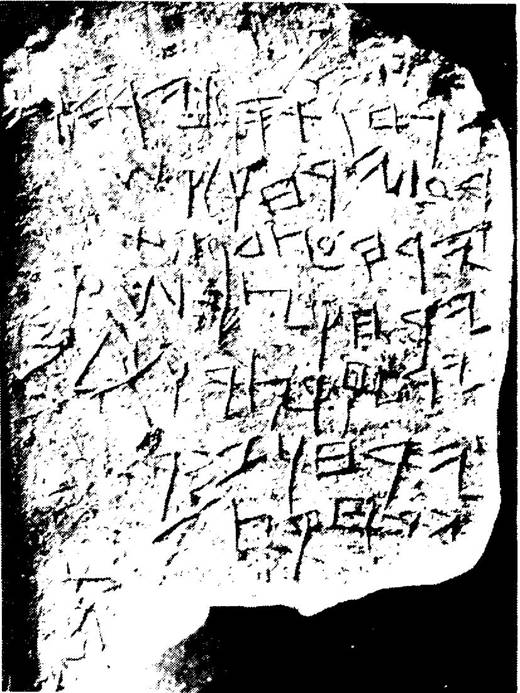
The relic shown above is a rare example of ancient Hebrew script. It is a part of what is known as the Gezer Calendar. Named after the city in which it was found, this highly prized ancient clay artifact, written about 925 b.c.e., proves two things:
(1.) The ancient Israelites wrote in ancient Hebrew script, and
(2.) The ancient Israelites used a calendar.
These broken pieces of pottery shown below are known as the "Lachish Letter #4"
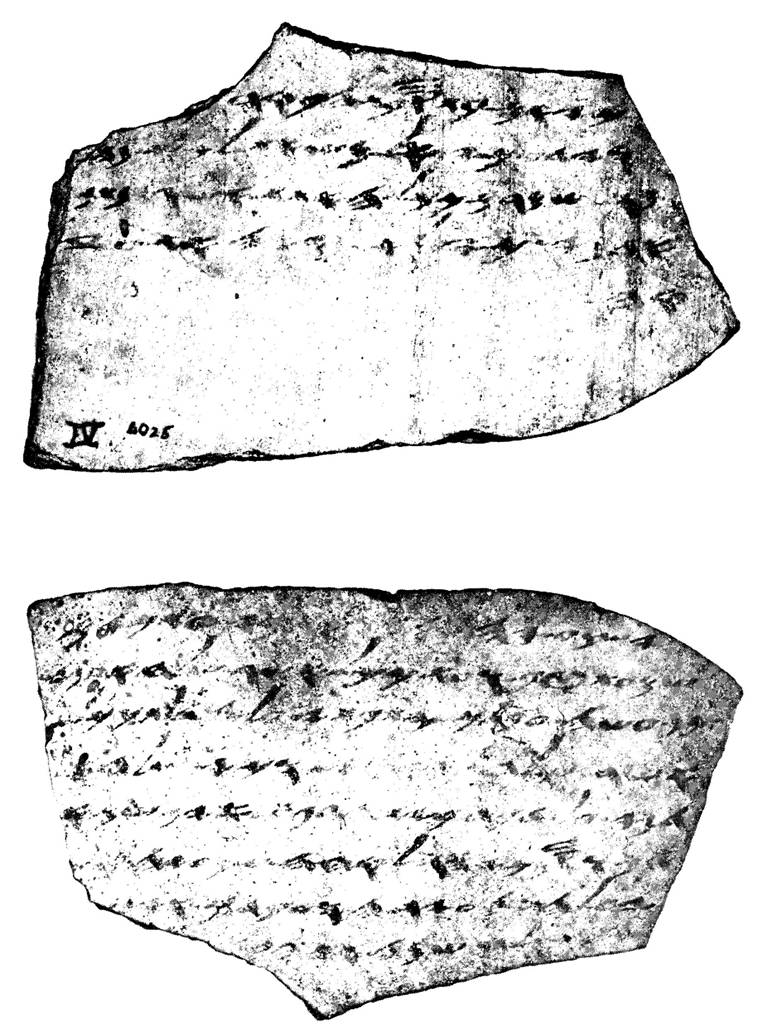
"Lachish Letter #4" was written during the time of the Babylonian invasion of Judah; approx. 588 b.c.e. Written in ancient Hebrew script, they contain correspondence between Lachish and it's military outpost. The writer used brush and ink to script this message on smooth clay, as opposed to using a sharp stylus on wet clay.
By 500 b.c.e., the true nation of Israel had been totally destroyed. First by Arameans; then by Assyrians, then Babylonians, and finally by Persians, the Israelites were conquered and disbursed by these nations. These events happened from about 2,500 to 2,700 years ago.
As a conquered people, the Israelites began to write their language using Aramean script. During the time of the Israelite scribe Ezra, the old Canaanite hieroglyphs, which were the basis of the ancient Hebrew script, were being replaced with the modern Aramean characters.
In fact, the Holy Scriptures we read today are written using Aramean characters. And, the scribe Ezra is given credit for being the one who originally converted the Holy Scriptures from ancient script to modern Aramean script.
The chart below shows the modern Aramean characters presently used to read and write the Hebrew language.
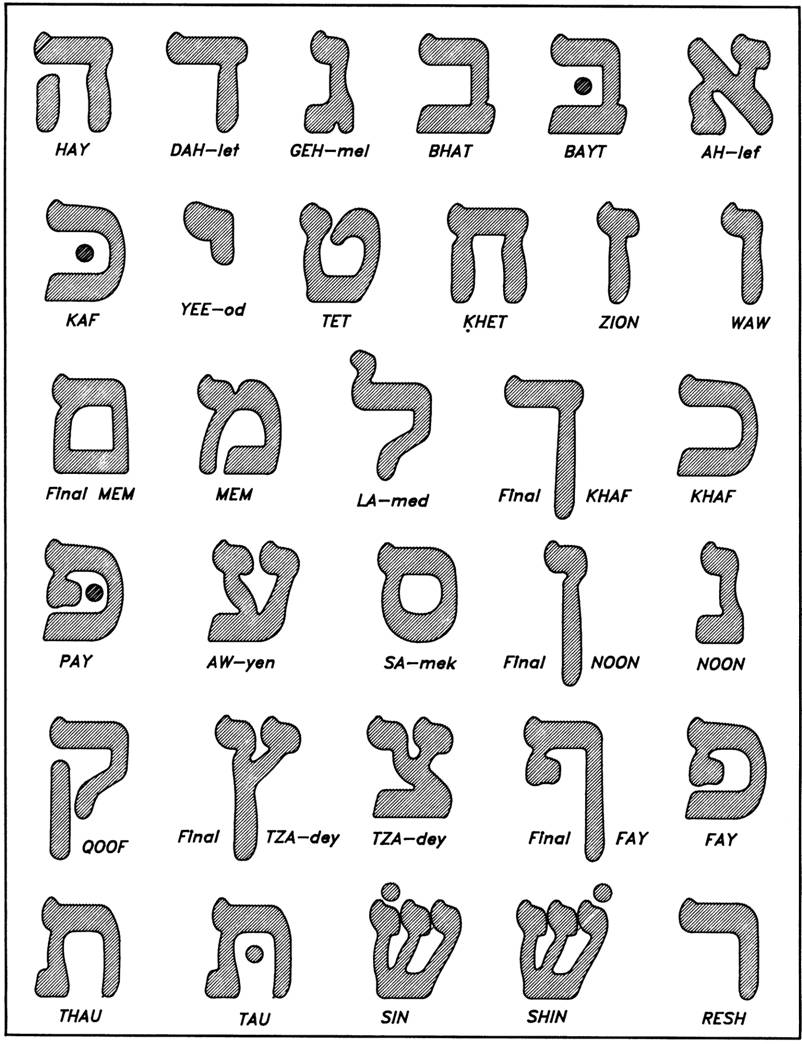
This next chart shows the same Aramean letters in what is called the BLOCK FORM.
It is the form used by students and teachers to write everyday Hebrew.
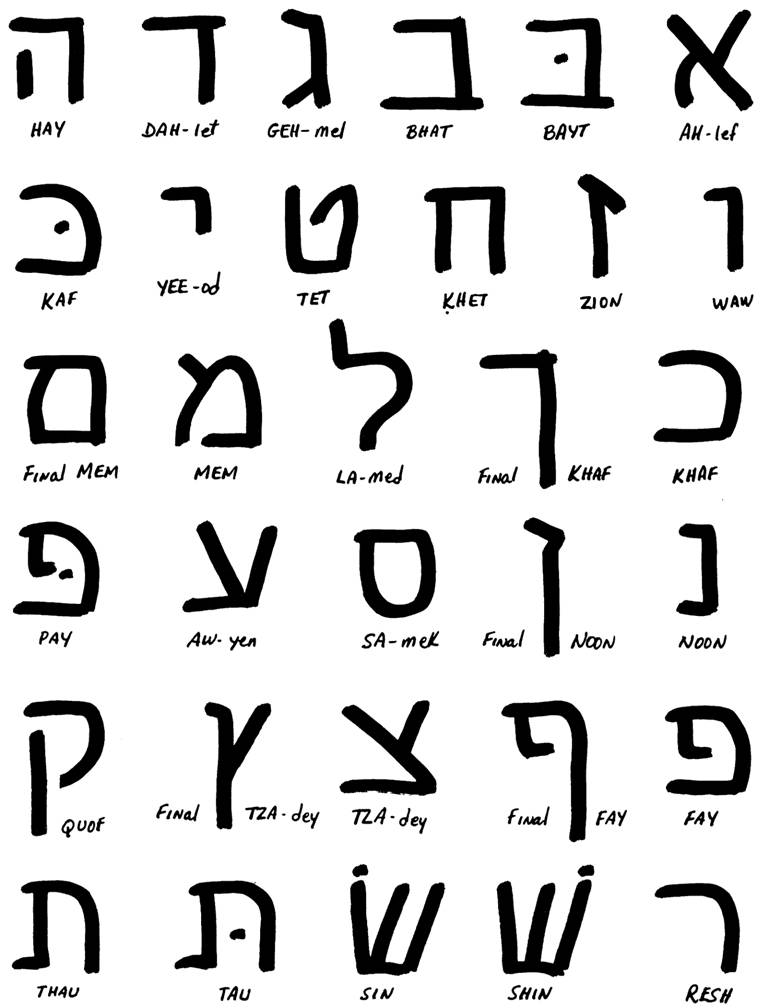
The inscription shown below is a replica of the original Ezra transcriptian - from about 2,500 years ago. Notice there are absolutely no punctuation marks used.
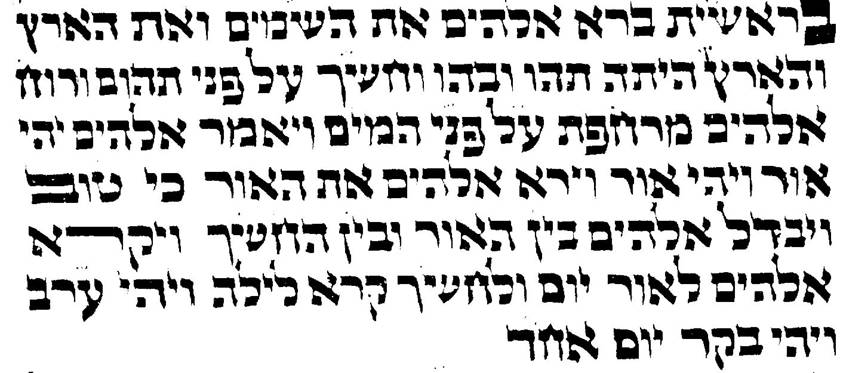
The scriptures shown above are the first five verses of the book of Genesis.
From the times of Ezra (approx. 485 b.c.e.), and for the next 1,000 years, the Hebrew spoken by the original Israelites had broken down into dozens of dialects. By then, the Hebrew spoken in Babylon could hardly be understood by those speaking Hebrew in Palestine. And, those speaking Hebrew in Egypt also had their own dialect. Thus, about 600 c.e., a group of learned "Jewish" scholars, called "Mesoretes", created a system of additional sound indicators that they applied to the original Ezra inscription. They placed symbols under, over, and inside the Aramean characters to indicate the exact sounding of the letters. They created this system in order to preserve what they consider to be the original ancient Israelite dialect.
The Mesoretic Sounding System
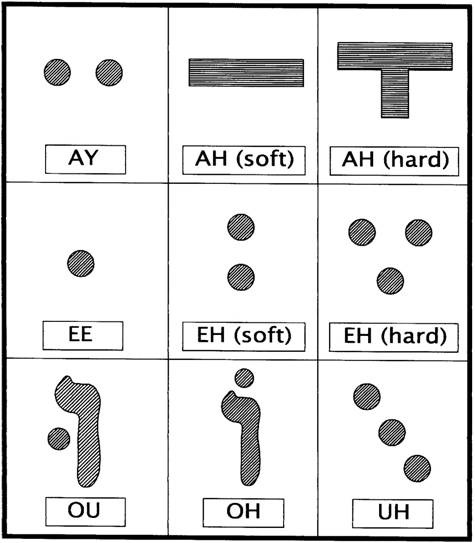
This chart shows the nine major Masoretic sound indicators:
Presently, publishers have progressed to the point of offering Hebrew translations of the Holy Scriptures in a most advanced format.
The Scriptures shown below are also the first five verses of the Torah; published by Zondervan Publishing House -1987 -Interlinear Hebrew/English Old Testament.
It incorporates the Masoretic Text within the original Ezra Script.
Unlike English translations of the Holy Scriptures, there is only one version of the Hebrew Text. All Hebrew renderings of the Holy Scriptures are exactly the same.
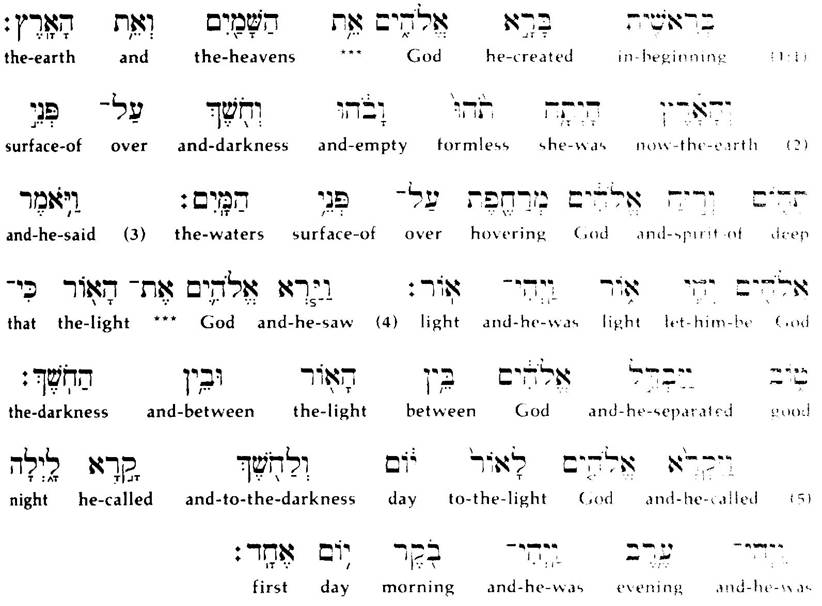
Presently, progressive publishers, such as Zondervan, are providing excellent aids to understanding the Hebrew Scriptures, as they are written by Ezra; including the Mesoretic sounding system. And, they go one incredible step further by sub-translating the actual original Hebrew text into English.
CREDITS
"The Bible as History"
by Werner Keller
William Morrow and Co. - New York - 1964
p.121 ... chart showing the development of the modern alphabet.
"Biblical Hebrew - Step by Step" (Vol.1 - Second Edition)
by Menahem Mansoor
Baker Book House - Grand Rapids, Michigan - 1988
p.20 ... image of Gezer Calendar
p.32 ... Image of Lachish Letter